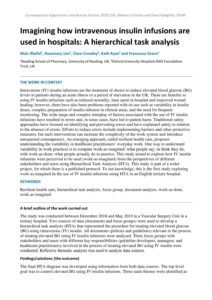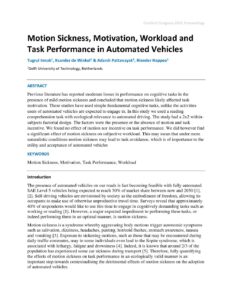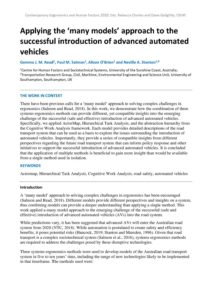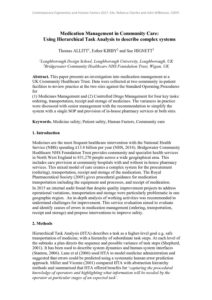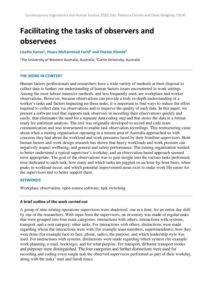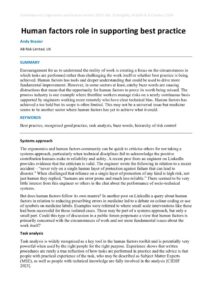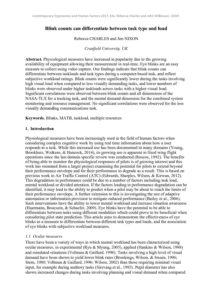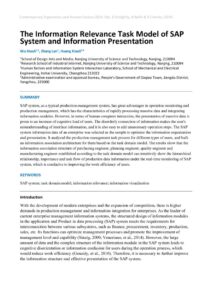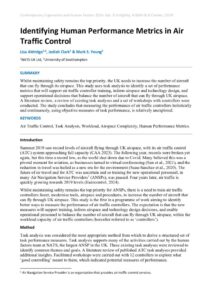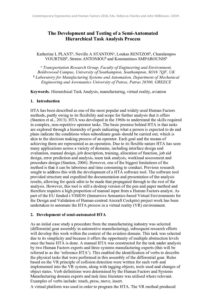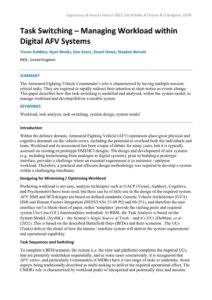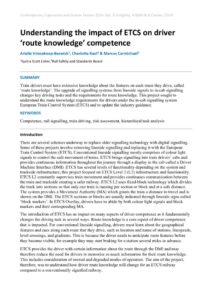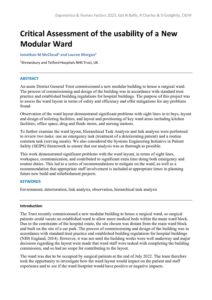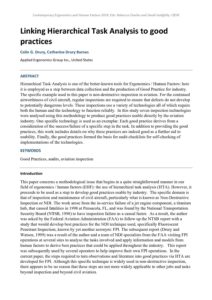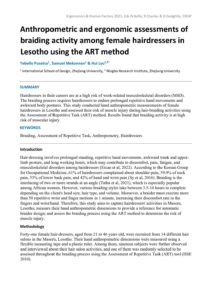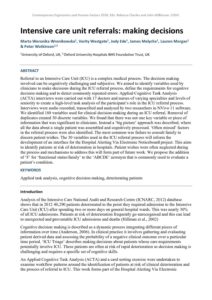Task analysis
Imagining how intravenous insulin infusions are used in hospitals: A hierarchical task analysis
| Document | Author Mais Iflaifel, Rosemary Lim, Clare Crowley, Kath Ryan and Francesca Greco |
| Abstract Intravenous (IV) insulin infusions are the treatment of choice to reduce elevated blood glucose (BG) levels in patients during an acute illness or a period of starvation in the UK. There are benefits to using IV insulin infusions such as reduced mortality, time spent in hospital and improved wound healing; however, there have also been problems reported with its use such as variability in insulin doses, complex preparation of insulin infusion in clinical areas, and the need for frequent monitoring. The wide range and complex interplay of factors associated with the use of IV insulin infusions have resulted in errors and, in some cases, have led to patient harm. Traditional safety approaches have focused on identifying and preventing errors and have explained safety in relation to the absence of errors. Efforts to reduce errors include implementing barriers and other protective measures, but such interventions can increase the complexity of the work system and introduce unexpected consequences. An emerging approach, called resilient health care, proposes understanding the variability in healthcare practitioners’ everyday work. One way to understand variability in work practices is to compare work-as-imagined: what people say, or think they do, with work-as-done: what people actually do in practice. This study aimed to explore how IV insulin infusions were perceived to be used (work-as-imagined) from the perspectives of different stakeholders and users using Hierarchical Task Analysis (HTA). This study is part of a wider project, for which there is a published protocol. To our knowledge, this is the first study exploring work-as-imagined in the use of IV insulin infusions using HTA in an English tertiary hospital. |
Motion Sickness, Motivation, Workload and Task Performance in Automated Vehicles
Applying the ‘many models’ approach to the successful introduction of advanced automated vehicles
| Document | Author Gemma J. M. Read, Paul M. Salmon, Alison O’Brien and Neville A. Stanton |
| Abstract There have been previous calls for a ‘many model’ approach to solving complex challenges in ergonomics (Salmon and Read, 2018). In this work, we demonstrate how the combination of three systems ergonomics methods can provide different, yet compatible insights into the emerging challenge of the successful (safe and effective) introduction of advanced automated vehicles. Specifically, we applied ActorMap, Hierarchical Task Analysis, and the abstraction hierarchy from the Cognitive Work Analysis framework. Each model provides detailed descriptions of the road transport system that can be used as a basis to explore the issues surrounding the introduction of automated vehicles. Importantly, they provide a series of compatible insights from different perspectives regarding the future road transport system that can inform policy response and other initiatives to support the successful introduction of advanced automated vehicles. It is concluded that the application of multiple methods is beneficial to gain more insight than would be available from a single method used in isolation. |
Medication Management in Community Care: Using Hierarchical Task Analysis to describe complex systems
| Document | Author Thomas ALLITT, Esther KIRBY and Sue HIGNETT |
| Abstract This paper presents an investigation into medication management at a UK Community Healthcare Trust. Data were collected at two community in-patient facilities to review practice at the two sites against the Standard Operating Procedures for (1) Medicines Management and (2) Controlled Drugs Management for four key tasks: ordering, transportation, receipt and storage of medicines. The variances in practice were discussed with senior management with the recommendation to simplify the system with a single SOP and provision of in-house pharmacy services at both sites. |
Facilitating the tasks of observers and observees
| Document | Author Lisette Kanse, Hawa Muhammad Farid and Florian Klonek |
| Abstract Human factors professionals and researchers have a wide variety of methods at their disposal to collect data to further our understanding of human factors issues encountered in work settings. Among the most labour-intensive methods, and less frequently used, are workplace and worker observations. However, because observations can provide a truly in-depth understanding of a worker’s tasks and factors impacting on these tasks, it is important to find ways to reduce the effort required to collect data via observations and to improve the quality of such data. In this paper, we present a software tool that supports task observers in recording their observations quickly and easily, that eliminates the need for a separate data coding step and that stores the data in a format ready for statistical analysis. The tool was originally developed to record and code team communication and was restructured to enable task observation recordings. This restructuring came about when a mining organisation operating in a remote area of Australia approached us with concerns they had about the workload and work pressures faced by their frontline supervisors. Both human factors and work design research has shown that heavy workloads and work pressure can negatively impact wellbeing, and general and safety performance. The mining organisation wanted to better understand a typical supervisor’s workday, and an observation-based approach seemed most appropriate. The goal of the observations was to gain insight into the various tasks performed, time dedicated to each task, how many and which tasks are juggled on an hour-by-hour basis, when peaks in workload occur, and which potential improvement areas exist to make work life easier for the supervisors and to better support them. |
Human factors role in supporting best practice
| Document | Author Andy Brazier |
| Abstract Encouragement for us to understand the reality of work is creating a focus on the circumstances in which tasks are performed rather than challenging the work itself or whether best practice is being achieved. Human factors has tools and deeper understanding that could be used to drive more fundamental improvement. However, in some sectors at least, catchy buzz words are causing distractions that mean that the opportunity for human factors to prove its worth being missed. The process industry is one example where frontline workers manage risks on a nearly continuous basis supported by engineers working more remotely who have clear technical bias. Human factors has achieved a toe hold but its scope is often limited. This may not be a universal issue but medicine seems to be another sector where human factors has yet to achieve what it could. |
Blink counts can differentiate between task type and load
| Document | Author Rebecca CHARLES and Jim NIXON |
| Abstract Physiological measures have increased in popularity due to the growing availability of equipment allowing their measurement in real-time. Eye blinks are an easy measure to collect using video capture. Our findings indicate that blink counts can differentiate between taskloads and task types during a computer-based task, and reflect subjective workload ratings. Blink counts were significantly lower during the tasks involving high visual load when compared to less visually demanding tasks, and lower numbers of blinks were observed under higher taskloads across tasks with a higher visual load. Significant correlations were observed between blink counts and all dimensions of the NASA-TLX for a tracking task, and the mental demand dimension for the combined system monitoring and resource management. No significant correlations were observed for the less visually demanding communications task. |
The Information Relevance Task Model of SAP System and Information Presentation
| Document | Author Wu Xiaoli, Zhang Lan, Huang Xiaoli |
| Abstract SAP system, as a typical production management system, has great advantages in operation monitoring and production management, which has the characteristics of rapidly processing massive data and integrating information modules. However, in terms of human-computer interaction, the presentation of massive data is prone to an increase of cognitive load of users. The disorderly connection of information makes the user's misunderstanding of interface information, and it is also easy to add unnecessary operation steps. The SAP system information data of an enterprise was selected as the sample to optimize the information organization and presentation. It analyzed the production management task process for different types of users, and built an information association architecture for them based on the task domain model. The results show that the information association structure of purchasing engineer, planning engineer, quality engineer and manufacturing engineer established according to the task domain model can intuitively show the hierarchical relationship, importance and task flow of production data information under the real-time monitoring of SAP system, which is conducive to improving the work efficiency of users. |
Identifying Human Performance Metrics in Air Traffic Control
| Document | Author Lisa Aldridge, Jediah Clark & Mark S. Young |
| Abstract Whilst maintaining safety remains the top priority, the UK needs to increase the number of aircraft that can fly through its airspace. This study uses task analysis to identify a set of performance metrics that will support air traffic controller training, inform airspace and technology design, and support operational decisions that balance the number of aircraft that can fly through UK airspace. A literature review, a review of existing task analyses and a set of workshops with controllers were conducted. The study concludes that measuring the performance of air traffic controllers holistically and continuously, using objective measures of task performance, is relatively unexplored. |
The Development and Testing of a Semi-Automated Hierarchical Task Analysis Process
| Document | Author Katherine L PLANT, Neville A STANTON, Loukas RENTZOS, Charalampos VOURTSIS, Stratos ANTONIOU and Konstantinos SMPAROUNIS |
| Abstract |
Task Switching – Managing Workload within Digital AFV Systems
| Document | Author Trevor Dobbins, Ryan Meeks, Dan Evans, Stuart Howe & Stephen Barrett |
| Abstract The Armoured Fighting Vehicle Commander’s role is characterised by having multiple mission critical tasks. They are required to rapidly redirect their attention at short notice as events change. This paper describes how this task-switching is modelled and analysed, within the system model, to manage workload and develop/deliver a useable system |
Understanding the impact of ETCS on driver ‘route knowledge’ competence
| Document | Author Arielle Vriesekoop-Beswick, Charlotte Kaul & Marcus Carmichael |
| Abstract Train drivers must have extensive knowledge about the features on each route they drive, called ‘route knowledge’. The upgrade of signalling systems from lineside signals to in-cab signalling changes key driving tasks and the requirements for route knowledge. This project sought to understand the route knowledge requirements for drivers under the in-cab signalling system European Train Control System (ETCS) and to update the industry guidance. |
Critical Assessment of the usability of a New Modular Ward
| Document | Author Jonathan M McCloud & Lauren Morgan |
| Abstract An acute District General Trust commissioned a new modular building to house a surgical ward. The process of commissioning and design of the building was in accordance with standard trust practice and established building regulations for hospital buildings. The purpose of this project was to assess the ward layout in terms of safety and efficiency and offer mitigations for any problems found. Observation of the ward layout demonstrated significant problems with sight lines in to bays, layout and design of toileting facilities, and layout and positioning of key ward areas including kitchen facilities, office space, drug and fluids stores, and nursing stations. To further examine the ward layout, Hierarchical Task Analysis and link analysis were performed to review two tasks: one an emergency task (treatment of a deteriorating patient) and a routine common task (serving meals). We also considered the Systems Engineering Initiative in Patient Safety (SEIPS) framework to ensure that our analysis was as thorough as possible. This work demonstrated significant problems with the ward layout, in terms of sight lines, workspace, communication, and contributed to significant extra time doing both emergency and routine duties. This led to a series of recommendations to mitigate on the ward, as well as a recommendation that appropriate staff involvement is included at appropriate times in planning future new build and refurbishment projects. |
Linking Hierarchical Task Analysis to good practices
| Document | Author Colin G. Drury, Catherine Drury Barnes |
| Abstract Hierarchical Task Analysis is one of the better-known tools for Ergonomics / Human Factors: here it is employed as a step between data collection and the production of Good Practice for industry. The specific example used in this paper is non-destructive inspection in aviation. For the continued airworthiness of civil aircraft, regular inspections are required to ensure that defects do not develop to potentially dangerous levels. These inspections use a variety of technologies all of which require both the human and the technology to function reliably. In this study seven inspection technologies were analysed using this methodology to produce good practices usable directly by the aviation industry. One specific technology is used as an exemplar. Each good practice derives from a consideration of the success/failure of a specific step in the task. In addition to providing the good practices, this work includes details on why these practices are indeed good as a further aid to usability. Finally, the good practices formed the basis for audit checklists for self-checking of implementations of the technologies. |
Anthropometric and ergonomic assessments of braiding activity among female hairdressers in Lesotho using the ART method
| Document | Author Tebello Pusetso, Samuel Mekonnen & Hui Lyu |
| Abstract Hairdressers in their careers are at a high risk of work-related musculoskeletal disorders (MSD). The braiding process requires hairdressers to endure prolonged repetitive hand movements and awkward body postures. This study conducted hand anthropometric measurements of female hairdressers in Lesotho and assessed their risk of muscle injury during hair-braiding activities using the Assessment of Repetitive Task (ART) method. Results found that braiding activity is at high risk of muscular injury. |
Intensive care unit referrals: making decisions
| Document | Author Marta Weronika Wronikowska, Verity Westgate, Jody Ede, James Malycha, Lauren Morgan & Peter Watkinson |
| Abstract Referral to an Intensive Care Unit (ICU) is a complex medical process. The decision making involved can be cognitively challenging and subjective. We aimed to identify variables used by clinicians to make decisions during the ICU referral process, define the requirements for cognitive decision making and to detect commonly repeated errors. Applied Cognitive Task Analysis (ACTA) interviews were carried out with 17 doctors and nurses of varying specialties and levels of seniority to create a high-level task analysis of the participant’s role in the ICU referral process. Interviews were audio recorded, transcribed and analysed by two researchers in NVivo 11 software. We identified 188 variables used for clinical decision-making during an ICU referral. Removal of duplicates created 30 discrete variables. We found that there was not one key variable or piece of information that was significant to clinicians. Instead a ‘big picture’ approach was described, where all the data about a single patient was assembled and cognitively processed. ‘Often missed’ factors in the referral process were also identified. The most common was failure to consult family to discern patient wishes. The 30 variables used in the ICU referral process will inform the development of an interface for the Hospital Alerting Via Electronic Noticeboard project. This aims to identify patients at risk of deterioration in hospitals. Patient wishes were often neglected during the process and mechanisms to address this will form part of future work. We propose the addition of ‘F’ for ‘functional status/family’ to the ‘ABCDE’ acronym that is commonly used to evaluate a patient’s condition. |

